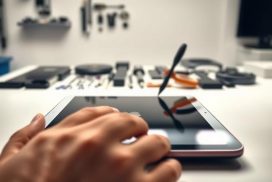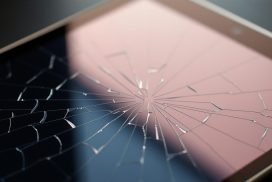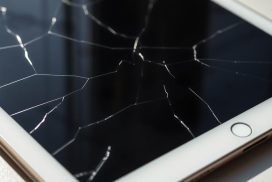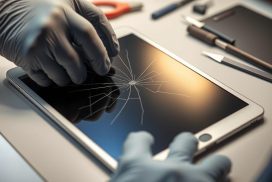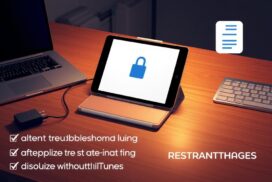iPad Air Gyroscope and Accelerometer Calibration
Welcome to our guide on iPad Air gyroscope and accelerometer calibration. The iPad Air is equipped with advanced motion sensing capabilities, thanks to its built-in gyroscope and accelerometer. However, to maintain optimal performance, these sensors may require calibration over time. In this article, we will explore the process of calibrating the gyroscope and accelerometer on your iPad Air to ensure accurate navigation and motion sensing.
The gyroscope on your iPad Air measures angular velocity and detects changes in orientation, enabling precise motion sensing. If you experience issues with screen orientation or misbehaving apps, recalibrating the gyroscope can help resolve these problems. Additionally, the accelerometer measures acceleration and tilt, ensuring the device adjusts the screen orientation correctly. If you notice inconsistencies in screen orientation or responsiveness, recalibrating the accelerometer is recommended.
In the upcoming sections, we will outline the step-by-step process for gyroscope and accelerometer calibration, as well as provide troubleshooting tips for screen orientation issues. We will also explore additional calibration techniques to optimize the performance of your iPad Air. Finally, we will introduce the Sensor Logger app, which allows users to collect and analyze data from various sensors, including the gyroscope and accelerometer.
By following the guidelines in this article, you can maintain accurate motion sensing on your iPad Air, enhance its functionality, and enjoy a seamless user experience. Let’s get started with gyroscope calibration in the next section.
Understanding Gyroscope Calibration
Gyroscope calibration is essential for accurate motion sensing on your iPad Air. The gyroscope measures angular velocity and can detect changes in the device’s orientation. If you are experiencing issues with screen orientation or misbehaving apps, recalibrating the gyroscope may help resolve the problem.
Recalibrating the gyroscope on your iPad Air is a straightforward process that can be done following the steps provided by Apple’s support. By performing gyroscope calibration, you can improve the accuracy of motion sensing on your device, ensuring smoother navigation and a better user experience.
When recalibrating the gyroscope, it’s important to ensure that your iPad Air is on a flat and stable surface. This will provide a reference point for accurate calibration. Follow the on-screen instructions and move the device as indicated to complete the gyroscope calibration process.
By keeping your iPad Air’s gyroscope properly calibrated, you can enjoy enhanced performance in applications that rely on motion sensing, such as games and augmented reality (AR) experiences. Additionally, recalibrating the gyroscope can help resolve any screen orientation issues you may be encountering, ensuring that the device accurately adjusts to your movements.
Benefits of Gyroscope Calibration:
- Improved accuracy in motion sensing applications
- Better responsiveness to device orientation changes
- Corrects screen orientation issues
- Enhances user experience
To recalibrate the gyroscope on your iPad Air, follow these steps:
- Open the “Settings” app on your iPad Air
- Select “General” from the menu
- Scroll down and tap on “Accessibility”
- Choose “Motion” from the available options
- Tap on “Motion Calibration & Distance” to enter the calibration process
- Follow the on-screen instructions to complete the gyroscope calibration
Once the gyroscope calibration is complete, test the device’s motion sensing capabilities by using applications or features that utilize it. If you continue to experience issues, it may be necessary to seek further assistance from Apple’s support or visit an Apple Store for additional troubleshooting.
“Recalibrating the gyroscope on your iPad Air can significantly improve its motion sensing accuracy and resolve screen orientation issues.” – Apple Support
Calibrating the Accelerometer
The accelerometer in your iPad Air is vital for measuring the device’s acceleration and tilt. It plays a crucial role in detecting changes in the device’s position and adjusting screen orientation accordingly. If you notice inconsistencies in the screen orientation or responsiveness, recalibrating the accelerometer may be necessary. Follow these recommended steps to easily recalibrate the accelerometer on your iPad Air and ensure accurate motion sensing:
- Open the Settings app: Launch the Settings app on your iPad Air by tapping on the gear icon.
- Go to Display & Brightness: In the Settings menu, locate and tap on “Display & Brightness.”
- Select the View option: On the Display & Brightness screen, tap on the “View” option.
- Toggle the motion calibration switch: Within the View settings, find the “Motion Calibration” toggle switch and swipe it to the Off position. Wait for a few seconds, then swipe it back to the On position to recalibrate the accelerometer.
Once you have completed these steps, the accelerometer on your iPad Air should be recalibrated, ensuring accurate motion sensing and resolving any screen orientation or responsiveness issues you may have encountered.
Expert Tip:
If you continue to experience problems with your iPad Air’s accelerometer despite recalibration, you may consider contacting Apple Support for further assistance. They can provide you with additional troubleshooting steps or advise on any potential hardware issues that may be affecting the device’s performance.
Now that you understand how to recalibrate the accelerometer, you can optimize your iPad Air’s functionality and enjoy accurate motion sensing for a seamless user experience.
Continue reading to discover troubleshooting techniques for screen orientation issues on your iPad Air. You’ll find helpful tips and methods to address any problems you may encounter.
Troubleshooting Screen Orientation Issues
Dealing with screen orientation issues on your iPad Air can be incredibly frustrating. Whether your device constantly flips upside down or displays sideways when it shouldn’t, these problems can disrupt your user experience. You may encounter screen orientation issues on the lock screen, home screen, or even within specific apps. Fortunately, there are several troubleshooting techniques you can try to fix these problems and restore your iPad Air’s correct screen orientation.
One method to troubleshoot screen orientation issues is by wrangling with the iPad itself. Try rotating the device in different directions, paying close attention to any changes in screen orientation. This physical manipulation can sometimes trigger the automatic screen rotation feature and help resolve the issue.
If wrangling with the iPad doesn’t yield any results, you can attempt to fix screen orientation problems by killing and reopening misbehaving apps. Misbehaving apps can sometimes disrupt the proper functioning of the screen rotation feature. Close the problematic app by double-clicking the home button and swiping up on the app’s preview to close it. Then, relaunch the app and check if the screen orientation issue persists.
Note: Be sure to save any unsaved work or data within the app before closing it, as closing the app will terminate any unsaved progress.
If troubleshooting on your own doesn’t resolve the screen orientation problem, it may be beneficial to seek assistance from Apple’s Genius Bar. The Genius Bar is a support service provided by Apple that offers hands-on technical support for Apple devices. You can schedule an appointment at an Apple Store and have an expert examine your iPad Air to identify and resolve any persistent screen orientation issues you may be experiencing.
Remember, it’s important to get screen orientation issues fixed promptly, as they can significantly impact your productivity and overall user experience with the iPad Air. Don’t hesitate to reach out for professional assistance when troubleshooting on your own isn’t sufficient.
Troubleshooting Techniques for Screen Orientation Issues
| Technique | Description |
|---|---|
| Wrangling with the iPad | Physically rotate the iPad in different directions to trigger the automatic screen rotation feature. |
| Killing and reopening misbehaving apps | Close the misbehaving app and relaunch it to reset the screen orientation. |
| Seeking assistance from Apple’s Genius Bar | Schedule an appointment with Apple’s Genius Bar for professional support and troubleshooting. |
Additional Tips for Calibration
In addition to gyroscope and accelerometer calibration, there are other calibration tips that can help improve the performance of your iPad Air. By following these additional calibration techniques, you can optimize the overall functionality of your iPad Air and enhance its navigation and motion sensing capabilities.
Adjust Brightness Settings
One important aspect of calibration is adjusting the brightness settings on your iPad Air. By ensuring that the screen brightness is set at an optimal level, you can enhance the visibility and clarity of the display. This can make a significant difference, especially when using apps and viewing content that relies heavily on accurate color representation and image quality.
Enable Compass Calibration and Motion Calibration
Compass calibration and motion calibration are essential for accurate navigation on your iPad Air. By enabling these features in the settings, you can ensure that the device accurately tracks your movements and responds accordingly. This is particularly useful when using navigation apps, playing games that require motion controls, or engaging in augmented reality experiences that rely on precise motion sensing.
Properly Calibrate the Battery
Calibrating the battery on your iPad Air can help optimize its performance and ensure accurate readings of remaining battery life. To properly calibrate the battery, you can follow these steps:
- Use your iPad Air until the battery drains completely and the device turns off.
- Connect your iPad Air to a power source and let it charge uninterrupted until it reaches 100%.
- Keep your iPad Air connected to the power source for an additional 1-2 hours to ensure a complete charge.
- Once fully charged, disconnect your iPad Air from the power source and restart the device.
By calibrating the battery regularly, you can ensure that the battery percentage displayed on your iPad Air is accurate and that the device’s battery life is optimized.
Remember, regular calibration of your iPad Air is essential for maintaining optimal performance and accuracy. By implementing these additional tips, you can enhance your iPad Air’s navigation and motion sensing capabilities, ensuring a seamless and enjoyable user experience.
Using Sensor Logger for Data Collection
Sensor Logger is a powerful app that allows users to collect and analyze data from various sensors on their iPhone, iPad, or Apple Watch. With its support for numerous sensors, including the accelerometer, gyroscope, GPS, audio, camera, and Bluetooth devices, Sensor Logger provides a comprehensive solution for data collection and analysis.
The app offers a range of features designed to enhance the data collection experience. One of its key functionalities is sensor logging, which allows users to record sensor data over time. This feature is particularly useful for monitoring changes in sensor readings or capturing data for research purposes.
When it comes to data analysis, Sensor Logger provides interactive plots that enable users to visualize their collected data. These plots offer insights into patterns, trends, and correlations within the collected data, facilitating a deeper understanding of the sensor’s behavior and performance. With the ability to export data in various formats, users can further analyze and share their findings as needed.
Sensor Logger also incorporates a custom rule engine that allows users to define specific conditions or triggers based on sensor data. This feature enables automated actions or notifications based on real-time sensor readings, enhancing the app’s versatility and adaptability for different use cases.
Benefits of Using Sensor Logger
- Efficient data collection from multiple sensors on iOS devices
- Comprehensive data analysis with interactive plots
- Easy export options for further analysis and sharing
- Custom rule engine for automated actions based on sensor data
- Support for a wide range of sensor types, including accelerometer, gyroscope, GPS, audio, camera, and Bluetooth devices
Whether you are a researcher, educator, or simply interested in exploring the capabilities of iPad sensors, Sensor Logger is a valuable tool for data collection, analysis, and sensor calibration. Its intuitive interface and powerful features make it a go-to app for those looking to harness the full potential of their iOS devices’ sensor capabilities.
“Sensor Logger offers a seamless experience for collecting and analyzing data from iPad sensors. Its intuitive interface, comprehensive feature set, and support for various sensor types make it a valuable asset for anyone interested in data collection and analysis.” – Dr. Emma Johnson, Research Scientist
With Sensor Logger, harness the power of your iPad sensors and unlock a world of possibilities in fields such as physics, science, technology, engineering, and mathematics (STEM).
Conclusion
Ensuring the proper calibration of the gyroscope and accelerometer on your iPad Air is crucial for accurate navigation and motion sensing. By following the recommended steps and utilizing tools such as Sensor Logger, you can maintain optimal performance and address any issues related to screen orientation or responsiveness. However, if problems persist or require further assistance, it is advisable to seek support from Apple’s Genius Bar or consult the official Apple support resources.
Keeping your iPad Air calibrated is essential to enjoy precise motion sensing and a seamless user experience. Whether you use your device for work, entertainment, or both, having reliable and accurate sensors is vital. By following the calibration techniques outlined in this article, you can ensure that your iPad Air performs at its best and provides you with the functionality you need.
Remember, calibration is not a one-time process. As you continue to use your iPad Air, it is recommended to periodically recalibrate the gyroscope and accelerometer to maintain their accuracy. By doing so, you can optimize the performance of your device and enjoy smooth, reliable motion sensing capabilities.
FAQ
Why is gyroscope calibration important for the iPad Air?
Gyroscope calibration is essential for accurate motion sensing on your iPad Air. It helps improve the accuracy of motion detection and resolves issues with screen orientation or misbehaving apps.
How do I calibrate the gyroscope on my iPad Air?
To recalibrate the gyroscope on your iPad Air, you can follow the steps provided by Apple’s support. These steps will help you perform gyroscope calibration and improve the accuracy of motion sensing on your device.
What is the accelerometer responsible for in my iPad Air?
The accelerometer in your iPad Air measures the device’s acceleration and tilt. It detects changes in position and adjusts screen orientation accordingly. It is crucial for accurate motion sensing and screen responsiveness.
How can I calibrate the accelerometer on my iPad Air?
To calibrate the accelerometer on your iPad Air, you can follow the recommended steps provided by Apple. This will help ensure accurate motion sensing and resolve any inconsistencies in screen orientation or responsiveness.
What can I do to troubleshoot screen orientation issues on my iPad Air?
If you are facing screen orientation problems on your iPad Air, you can try various techniques such as wrangling with the device, killing and reopening misbehaving apps, or seeking assistance from Apple’s Genius Bar. It is recommended to schedule an appointment and show your iPad Air to Apple for further assistance in resolving persistent screen orientation issues.
Are there any additional calibration tips for my iPad Air?
Yes, apart from gyroscope and accelerometer calibration, there are other tips to enhance the performance of your iPad Air. These include adjusting brightness settings, enabling compass calibration and motion calibration, and properly calibrating the battery. Following these techniques will optimize the functionality of your iPad Air’s navigation and motion sensing capabilities.
What is Sensor Logger and how can it help with calibration?
Sensor Logger is a powerful app that allows users to collect and analyze data from various sensors on their iPad Air, iPhone, or Apple Watch. It supports sensors such as the accelerometer, gyroscope, GPS, audio, camera, and Bluetooth devices. Sensor Logger is particularly beneficial for researchers, educators, and individuals interested in fields such as physics, science, technology, engineering, and mathematics (STEM). It provides sensor logging, data visualization through interactive plots, export options, and a custom rule engine for analysis.

